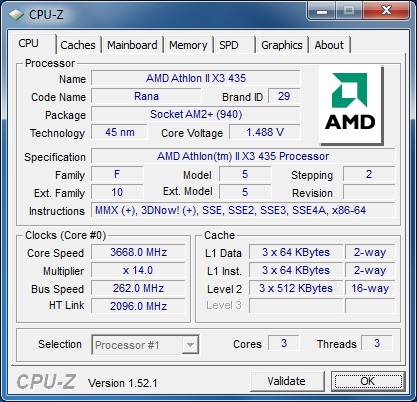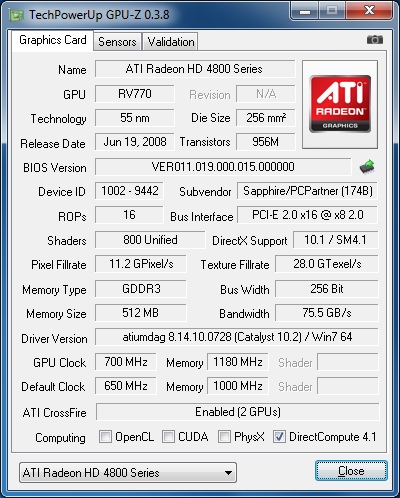System Builder Marathon, March 2010: $750 Gaming PC
Overclocking
Overclocking
Three processing cores and fairly high 2.9 GHz stock core speeds allow the Athlon II X3 435 to put up a good show for such an affordable CPU. But with stock benchmarks out of the way, we certainly wanted to see what sort of extra performance could be squeezed out of our $750 system.
As we have often stated, overclocking is luck of the draw and results vary from chip to chip. Our Athlon II came with a high 1.425V VID, meaning we wouldn’t be pushing more than about 5% (0.075V) more volts when dialing in our overclock.
This isn’t a Black Edition chip, so core speeds are raised by increasing the reference clock from the stock 200 MHz. For additional information on how to do this, refer to our guide on overclocking a locked AMD processor.
Here the fun all begins within Gigabyte’s MB Intelligent Tweaker (M.I.T.) BIOS menu. We lowered the CPU northbridge frequency, HyperTransport link frequency, CPU clock ratio multipliers (as well as the memory clock ratio), and then proceeded to find the maximum reference clock for our motherboard and CPU combo. Testing halted upon reaching a stable 300 MHz, as we knew this was beyond necessary given the high available 14.5x CPU multiplier.
Attention now turns toward finding the maximum core speed for our three-core Athlon II CPU. At stock 1.425V, we find stability at 3.5 GHz (14 x 250 MHz). A 0.075V bump in the CPU voltage control and CPU northbridge VID control (to 1.5V and 1.25V, respectively) gives us a maximum stable overclock of 3,668 MHz. It doesn't matter whether "14 x 262 MHz" or "14.5 x 253 MHz" is used, so we have both options available for memory and northbridge tweaking. While these aren’t outstanding results, they fall right in line with the majority of test samples used in launch reviews.
Despite the 1.5V rating of our G.Skill Ripjaws, the lowest available DDR voltage in Gigabyte’s F3 BIOS was 1.6V. After a boost to 1.65V, we still had no luck with stable RAM frequency above DDR3-1659, so extra performance was instead gained by running DDR3-1396 at reduced 7-8-7-15 timings, as well as jacking the northbridge frequency up to 2,620 MHz.
As mentioned above, these Sapphire Radeon HD 4850s were already slightly overclocked out of the box. But both of these cards have far more to give, and are stable all the way up to Catalyst Control Center's maximum 700 MHz GPU core and 1,200 MHz (2,400 MHz effective) memory. Considering the exact limit was unknown, the memory was knocked down 20 MHz for performance testing.
Get Tom's Hardware's best news and in-depth reviews, straight to your inbox.
-
erdinger Good job. I Really like the system and I agree in nearly every decision.Reply
unlocking the forth core and still overclocking to 3.6Ghz is just great! I'm getting jealous because my 4th core is broken.
I'm looking forward to the value comparison. -
cruiseoveride This is almost identical to my build. But I used 2nd hand parts, dual HD4870s and it worked out just less than $600.Reply
4 cores, 3.2Ghz, 13,000 3dmark points.
Great bang-for-buck system. -
stray_gator Apart from a SBM entry, this article also provides reality check regarding the benefits of a fourth core. quite useful.Reply -
jsowoc I find the value comparisons are usually (always?) that the least expensive computer has the most "value", followed closely by the middle computer, trailed by the most expensive setup.Reply
Would it be possible to make a 3-way comparison of systems at the same price (for example, $1000)? One could be an AMD-based system, another an Intel-based, and a third maybe a graphics-heavy monster, or a MicroATX system (to see how much performance you sacrifice to stay in $1000 and fit a small form factor). -
Otus What would by interesting is a round of "upgrade" builds. Set specific budgets for ungrades and add them on top of the hardware from a previous round. That would allow commentary on upgrade paths and also help builders of new rigs.Reply -
Crashman jsowocI find the value comparisons are usually (always?) that the least expensive computer has the most "value", followed closely by the middle computer, trailed by the most expensive setup.Would it be possible to make a 3-way comparison of systems at the same price (for example, $1000)? One could be an AMD-based system, another an Intel-based, and a third maybe a graphics-heavy monster, or a MicroATX system (to see how much performance you sacrifice to stay in $1000 and fit a small form factor).Reply
Except for the CPU cooler, you usually sacrifice nothing to go Micro ATX. Tom's Hardware even did a micro-ATX SBM...where the Core i7 system sucked because it had to use the stock cooler. You can find semi-small micro-ATX cases that fit mid-sized coolers.
Antec also makes a MICRO ATX MID TOWER which REALLY sux since it misses the point of Micro ATX completely, so I don't want to hear about that one.
And of course there's Micro ATX mini-towers with the same layout as full-ATX. You get all the performance of ATX and the big cooler, with a case that's around 14-15" tall. -
jsowoc CrashmanExcept for the CPU cooler, you usually sacrifice nothing to go Micro ATX. Tom's Hardware even did a micro-ATX SBM...where the Core i7 system sucked because it had to use the stock cooler. (...)Reply
My argument was not that they should do a $500-$1000-$2000 comparison of uATX builds - they did this. I was suggesting doing a $1000intel - $1000amd - $1000uATX comparison. -
tigerwraith I still dont understand why they went with 2 gfx cards. Ive seen in a lot of reviews that even the newest games dont always work right off the bat when using Crossfire or SLi, So why not spend the money on a 5770 for this. You get DX 11, Dual to Triple moniters, and passthrough. So say you wanted to build a budget HTPC that could game Id have went with the 5770 or 5830 not only would that be a great cpu to watch on a HDTV but you would only need the HDMI cable to run everything.Reply



